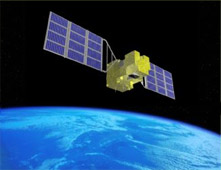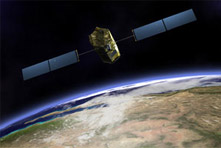
Q. What is Japan's cooperative relationship with the rest of the world?

Greenhouse Gases Observing Satellite GOSAT

The United States' Orbiting Carbon Observatory OCO (courtesy of NASA)
Besides GOSAT, there is another greenhouse-gas observation satellite in plan, OCO, the Orbiting Carbon Observatory, from the United States. It is scheduled to be launched in the fall of 2008, to monitor only CO2. Although the United States have not endorsed the Kyoto Protocol, they are aware of the necessity of greenhouse-gas reduction. They withdrew from the Kyoto Protocol saying that the 7 percent reduction requirement does not coincide with their national interest. However, they have announced that they will develop technologies to reduce their emissions by more than 7 percent, and each US state is working on greenhouse-gas reduction independently.
Having similar objectives, OCO and GOSAT share similar technological issues, and as such, we're planning some cooperative projects. For example, before launch we'll exchange and calibrate the devices used to measure sensor accuracy, so that we have common observation standards. And possibly, we'll compare data after launch and conduct calibration experiments together. We're also discussing shared data utilization.
Our observation principles are different, but using data gathered by both satellites will give us more detailed information on the conditions of greenhouse gases worldwide. We are currently working with U.S. officials on an agreement to provide all the GOSAT and OCO data to scientists from one source - what we call “one-stop shopping.”
Similar type of cooperation is in development with Europe too. European scientists will have no choice but to use Japanese or U.S. data because at the moment they don't have a satellite project of their own for regular monitoring of greenhouse gases. Therefore we are now discussing cooperation with Europe in the field of data transmission. GOSAT data is to be received at the Hatoyama Station in Japan and at the Svalbard Station in Norway. And then, in return for using the European network to transmit the data from Norway free of charge, we are in talk to provide scientists at the European Space Agency (ESA) with GOSAT data.
I think that international cooperation is essential, especially for Earth observation satellites. When monitoring the Earth from space, not just Japan but the entire planet is automatically covered. In that sense, I'd really like many people worldwide to make great use of GOSAT data, and I think that feedback from users will help improve observation performance.
Q. Do you think that Japanese people are very interested in global warming?
Yes, the Japanese have a very high interest in the issues. We have held three GOSAT symposia so far, and many members of the general public have participated. A great number of questions were raised at the symposia that international guests were wondering why the Japanese public has such a high awareness of global warming. It could be because the protocol is named after a Japanese city, Kyoto. But I think it also has to do with the fact that Japan is a pioneer in understanding CO2 global warming. Starting with Dr. Manabe's initial research in the 1970s, Japan now has many observation points. As I mentioned earlier, GOSAT observation data will be distributed from the World Data Centre for Greenhouse Gases, part of the WMO, which is operated, in fact, by Japan's Meteorological Agency. In short, all data on greenhouse gases are currently collected at Japan and distributed around the world. Also, Japan Airlines' regular flight between Japan and Australia is loaded with equipment to measure greenhouse gases, and has been collecting data twice a month for 14 years, since 1993. This data, which is very well known among scientists worldwide, is distributed through the WDCGG. Japan has been making notable contributions in the fields of meteorology and climate change, and it may be natural that the GOSAT project was born in such circumstances and that its data will be released globally.
Regrettably, though, Japan has not only been unable to reduce greenhouse-gas emissions, but on the contrary, our emissions have increased by 7 percent. The reduction requirement of the Kyoto Protocol for Japan is 6 percent, which means that Japan now has to cut 13 percent in total. China ranks second for the total volume of greenhouse gas emissions, but the fact is that Japan is producing more than China per capita. While China's per capita output is average, Japan's is 2.5 times the global average. Even if Japanese people try to reduce their emissions to one third of what we are now, we will still be merely the same as the global average.
Lately, the media has repeatedly covered the buzz around global warming, such as ”Cool Biz” (a campaign in the summer of 2005 to encourage business people to wear short-sleeved shirts, with no ties, as a method of saving energy on air-conditioning); “Team 6 Percent” (to help reach the country's Kyoto Protocol objectives); and the global warming learning facility “Stop OndanKan” in Tokyo, which provides free educational material on greenhouse-gas emissions. Also, 5,000 people across Japan are engaged in volunteer work through the Global Warming Committee. Nevertheless, why have greenhouse gases not been reduced? Reducing CO2 cannot be converted into money, and besides, its increase is invisible. No matter how much knowledge and motivation Japanese people might have, the reason we cannot cut greenhouse gases might be simply because they are imperceptible to our eyes.
Although people in Japan are very aware of the risks of increased greenhouse-gas emissions, I'm under the impression that the country hasn't gone any farther than just worrying about its 7-percent increase in emissions instead of a 6-percent reduction. At first, Europe seemed slow to take action, but they are now making steady progress, holding practical discussions on what to do and when. According to the British government's recent Stern Report, which is frequently cited, if quick action is taken to limit climate change now, it will cost nations only 1 percent of their GDP (gross domestic product) each year, which is much less than what it will cost if no action is taken.
Furthermore, at the EU Summit Conference in March 2007, a 20-percent greenhouse-gas reduction from 1990 levels by 2020 was advocated as a new target for post-Kyoto Protocol, which expires in 2013. Europe now seems a step ahead of Japan, but there are still many we can do in our daily life to improve our performance. For example, just by changing an incandescent bulb to a fluorescent lamp, we can cut power consumption by four fifths. We can reduce greenhouse gases with knowledge and wisdom. Each Japanese person probably needs to think about it.